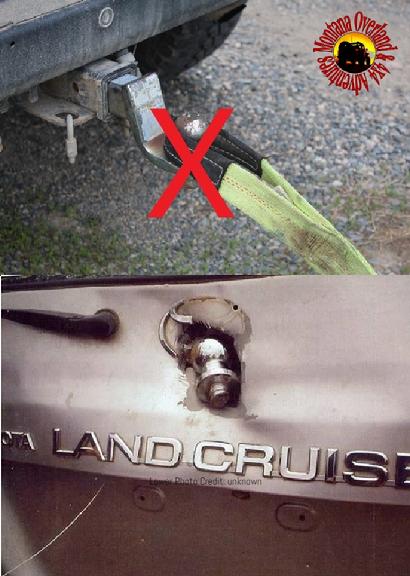OFF-ROAD 101
Some Helpful Hints:
|
ALWAYS Use A Tree Saver
The tree in the lower photo is very likely going to die. A large number of very lazy people have used it as an anchor for winching. Not a big deal if done correctly but many used it as an anchor without using a very aptly named, tree saver. The winch lines cut into the bark. This is kind of like strangling a tree.
Please, use a tree saver. You might just...get this...save a tree.
| |
| Water Crossings
Water crossings can, of course, be both dangerous and damaging to the environment. Some factors to consider include the water depth, the speed it is flowing, and your recovery plan if things go wrong. There is the threat of Hydro-locking your engine to keep in mind too.
Along with safety considerations, there are also environmental considerations. No matter the water you are crossing, legally we must use the shortest, safest path, while going as slow as possible and as fast as necessary, to connect to the trail on the other side. This minimizes the impact on the river/stream bed and your vehicle.
Going slower may not be as much fun, but it is a LOT more fun than seeing your favorite trails closed. So, in the end, it is just the right thing to do.
|
NO TOW BALLS (or a ball hitch) FOR SNATCH RECOVERIES
This has been in the news far too many times. Unfortunately, people still think throwing a snatch strap over the tow ball is okay when recovering a stuck 4WD. This is a dangerous mistake.
Tow balls are not intended or designed for the stresses a snatch strap or, in many cases, a winch can put on them. Some (Class II) 2" tow-balls are rated as low as 2000 lbs. Most Class III 2" balls and hitches are rated between 3500 & 6000 lbs. but can be rated up to 10,000 lbs. That is still insufficient strength to recover many bogged rigs safely when using rolling (kinetic) snatching techniques. If you snatch off a tow ball, it can shear off and go flying through the air like a cannonball.
That piece of flying metal has the potential to kill and has done so in the past. In just one example, a lady was killed while recovering a stuck 4WD in deep sand. The tow ball broke off the stuck vehicle and flew through the windshield of the recovery rig, and killed the driver. Such a tragedy, and she was just trying to help out. A similar death occurred in 2022 when a hitch and ball broke, went through a windshield and killed Aman in front of his family.
Please don't use tow-balls for recoveries. There are easy and far safer options, such as using a Shackle Hitch Receiver or, in a pinch, using the hitch pin.
Wheel Safe!!
|
 |
| Just Don't |
|
|
| A Little Winch Math:
Basic Winching and the effect of MUD.
What if your 4x4 is stuck in deep Mud? The depth of the bog (mire) will have a massive effect on the loaded weight of the vehicle being recovered. Here is a very simple guide for calculating the dead weight of the vehicle when in the mud. It's not scientific, but is is usable & easy to remember.
If stuck to the base of your wheels (known as "tire-depth"), it can require a pull of up to 75% to 100% of the loaded vehicle.
If stuck to the axles, it may require a pull of up to 150% of the weight of the stuck 4x4.
If stuck to the chassis/rocker panels+, depending on how deep, it can be 2x to 3x the total weight of the stuck vehicle! Think 2x at the rockers and 3x if you are bogged to the doors.
That's a potential pull of 300% of the load. 3x an average JKU Rubi is around 18,400lbs or so. So it is best to keep that in mind for a deeply mired rig.
Of course, pulling uphill makes things even worse.
Have your snatch block(s) handy, and make sure that ALL of your recovery gear is up to the task. And it is good form to pull out enough winch line that you are using the inner, more powerful layers on the drum for best results.
Wheel Safe!!
|
|